2021 Ford Bronco Review: Ford Builds a Better Wrangler
Ford’s revived Bronco brings civilization to off-road-ready SUVs.
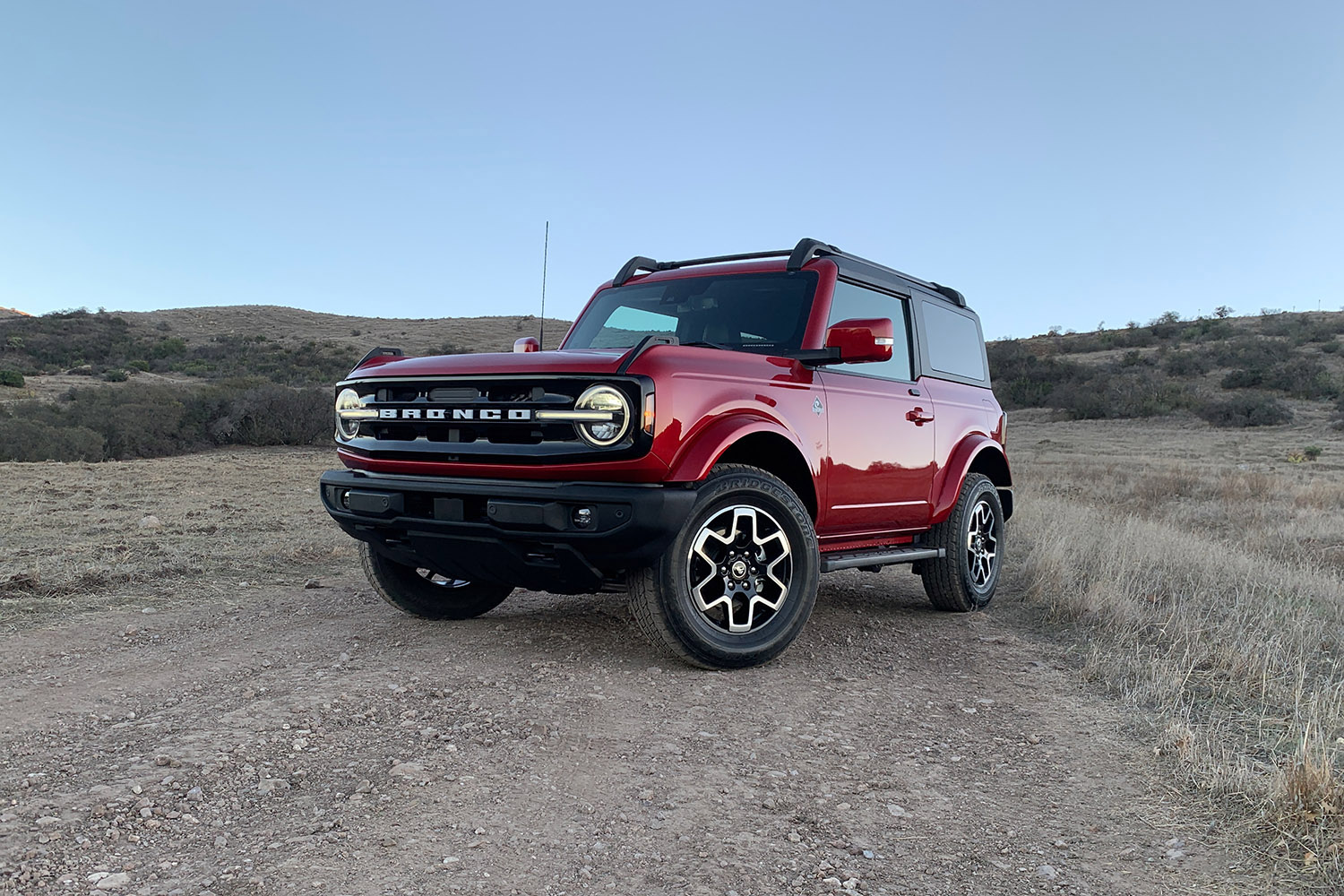 Christian Wardlaw
Christian Wardlaw
For years, I have wanted a Jeep Wrangler to complement my Mazdaspeed MX-5 Miata. Convertibles and Southern California go together like sun and sky, burgers and fries, Jay and Bey. Miatas are great for paved mountain roads, but not dirt-mountain trails. Therefore, a Jeep would make the perfect companion to the Mazda in my garage. Plus, it would hold both of my kids at the same time.
However, I’ve just spent a week driving the new 2021 Ford Bronco. And in many ways, it is the better of the two hardcore SUVs.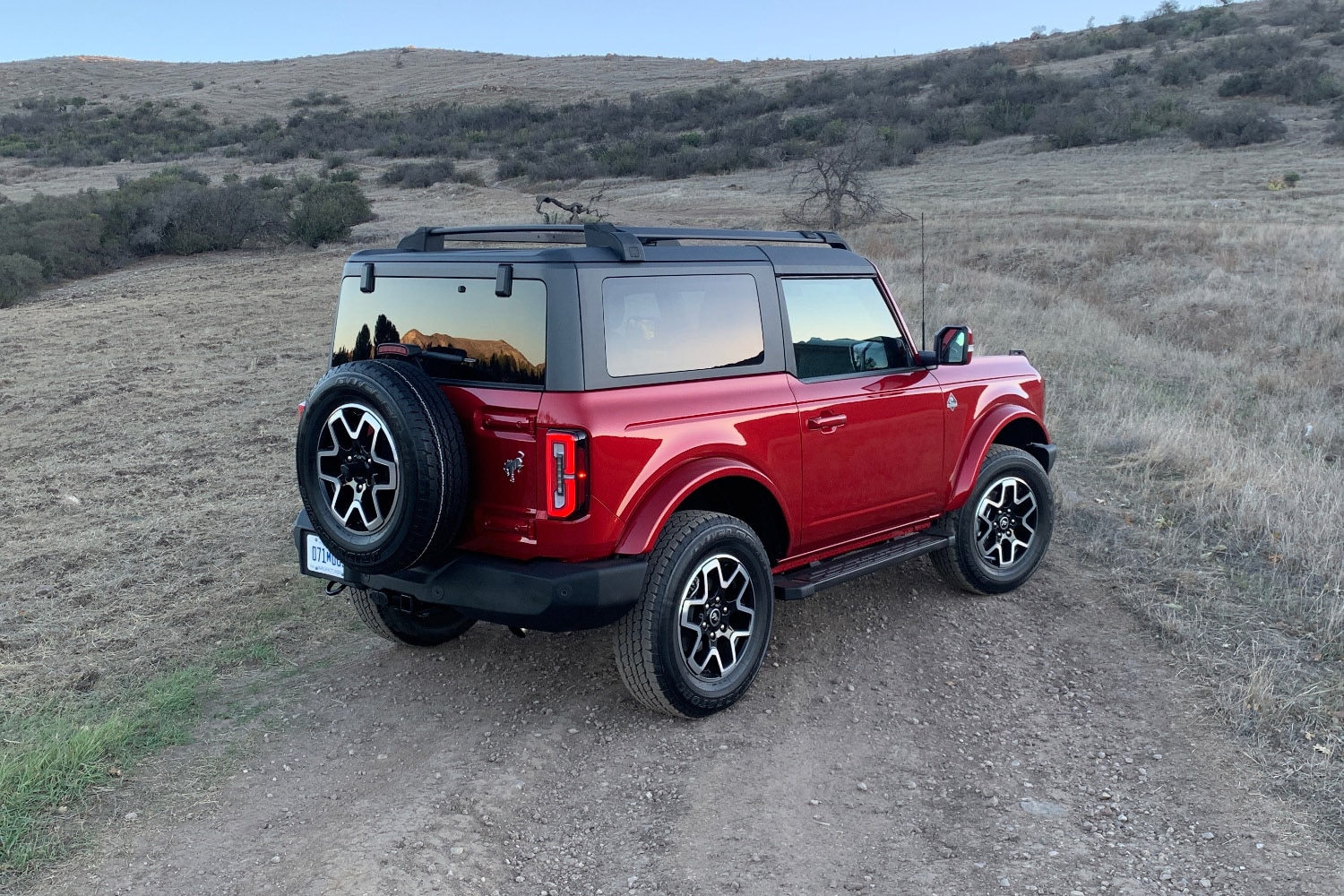 Christian Wardlaw
Christian Wardlaw
This assertion is not a knee-jerk reaction to the hype surrounding the return of the Bronco in all of its retro-themed glory. Taking its design cues from the original Bronco and not the F-150-based model that starred in the most famous Los Angeles police chase in history, the new 2021 Bronco has had off-roading enthusiasts drooling in anticipation of its arrival. Though curious about Ford’s revived off-road legend, I’ve been married to the idea of owning a Wrangler for so long that I was a little indifferent to driving the new Bronco. But, as it turns out, living with a Bronco for a week was an eye-opening experience.
Ford supplied a Bronco two-door for this review, equipped with Outer Banks trim, a twin-turbocharged V6 engine, the Lux option package, and several additional upgrades. Unfortunately, the Rapid Red paint color is gone for the 2022 model year, replaced by Hot Pepper Red. Otherwise, the test vehicle could pass for a 2022. Because Ford has already closed the order books on the 2021 Bronco, if you duplicated the test vehicle for 2022, the price would be nearly $51,000, including the destination charge.
You need not spend that much money on a new 2022 Bronco, though. Prices start at about $31,000 for a 2-door base model (including the destination charge). At the other end of the lineup, the 4-door Bronco Wildtrak begins at about $51,000. Later in 2022, the Bronco Raptor arrives to cap off the existing lineup, and a new Bronco Everglades model will slot in somewhere.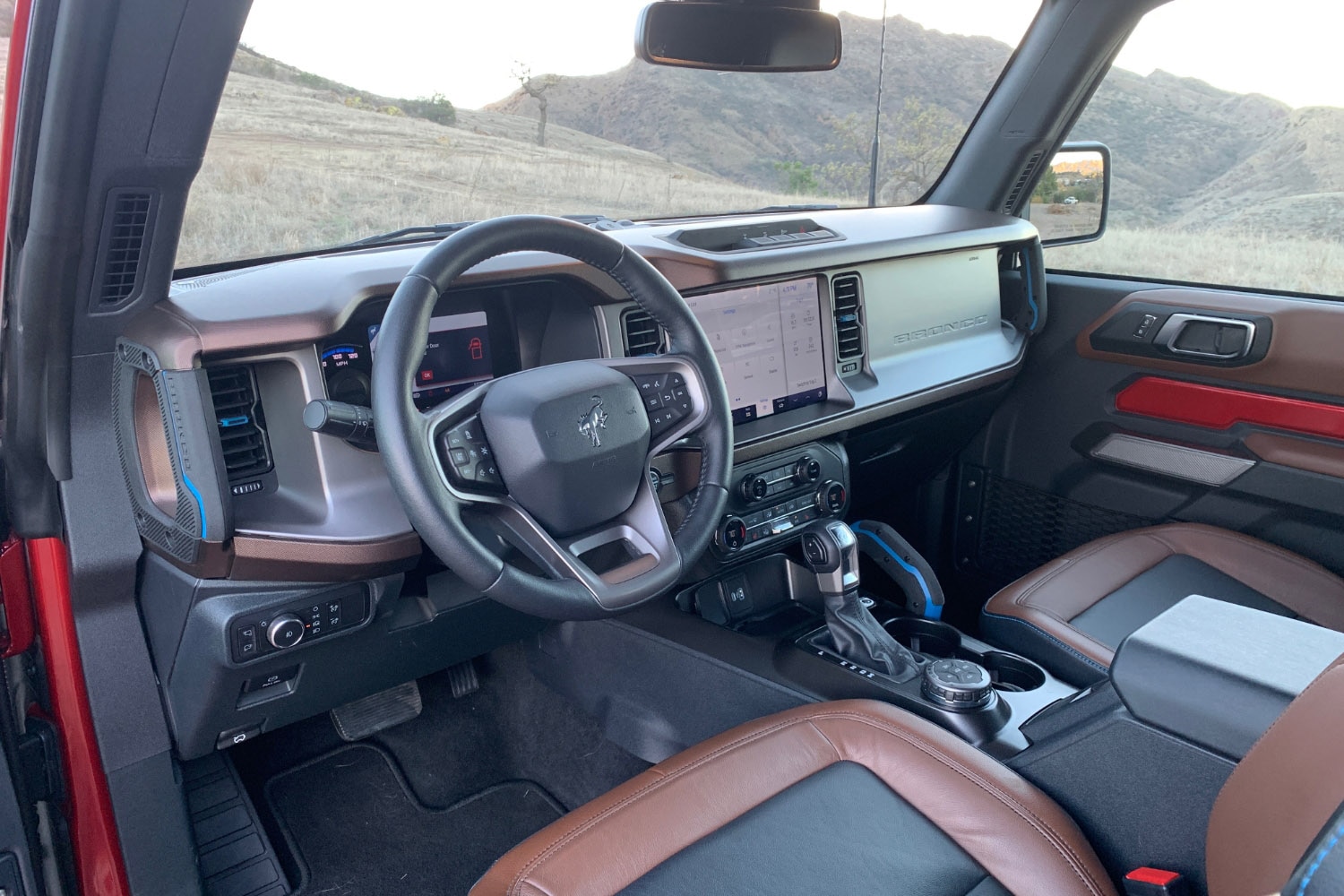 Christian Wardlaw
Christian Wardlaw
RETRO, BUT REFINED
Like its main rival from Jeep, the Ford Bronco’s exterior styling instantly recalls the past, but with a modern twist. The top comes off, and the removable doors open the Bronco's interior to the great outdoors. The SUV’s design details change with respective trim levels, giving each version of the Bronco a specific look.Considering the Bronco’s primary use case, it is unsurprising to find a cabin covered in hard plastic and rubbery surfaces that can get wet and muddy, and then clean up with reasonable ease.
The Outer Banks test vehicle came with the Lux package, making it about as luxe as a Bronco gets. The Lux package adds:
- Leather and vinyl seat upholstery
- Ambient lighting
- Dual-zone automatic climate control
- Heated front seats
- A heated steering wheel
- A 10-speaker premium sound system
- A 12-inch touchscreen infotainment system with navigation
- Added sound-deadening materials
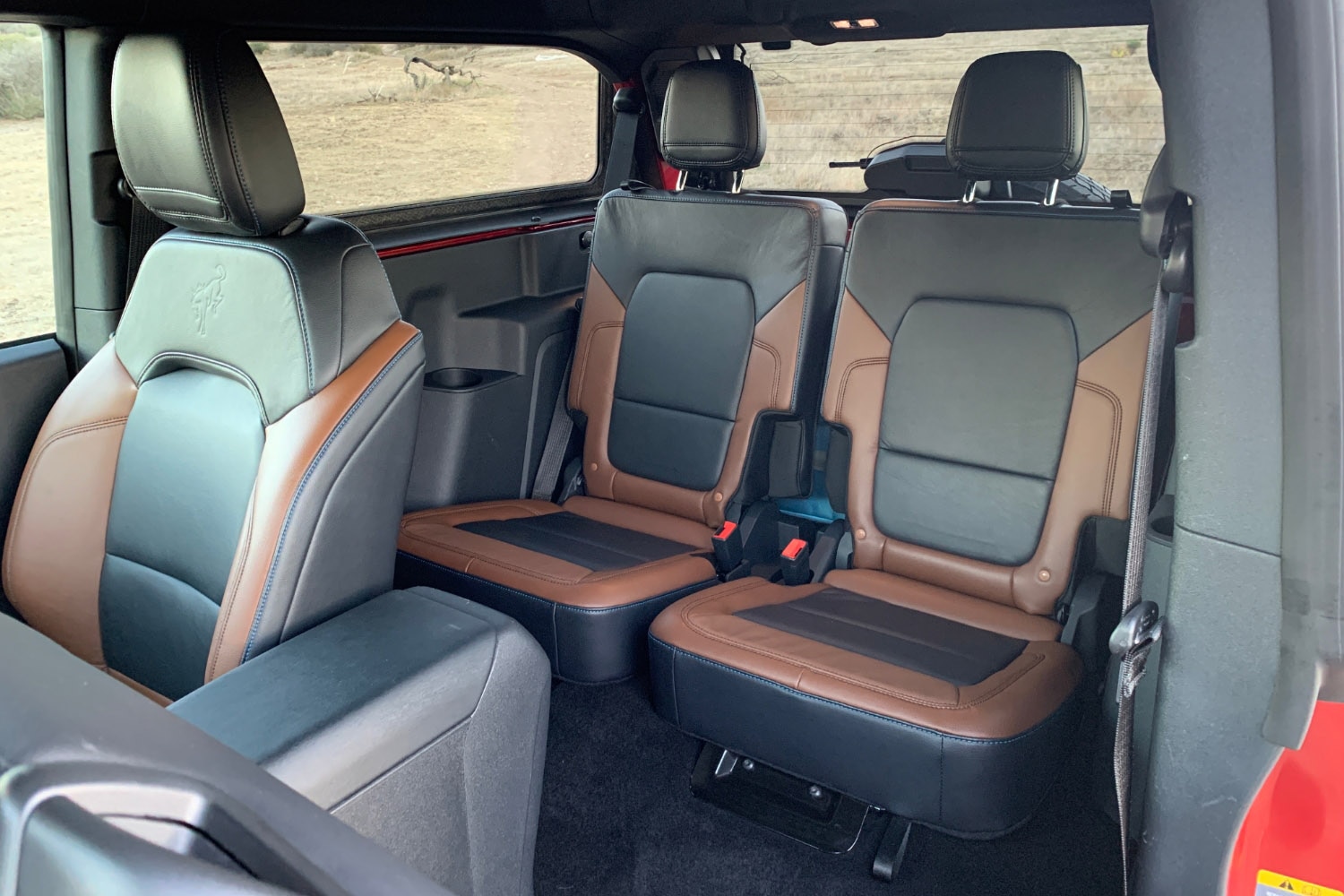 Christian Wardlaw
Christian Wardlaw
Quality is best described as durable, though some flimsy fittings exist. Ford logically arranges the controls; the power window switches mounted on the center console are the only oddity of the layout. A mix of digital and analog instrumentation offers drivers plenty of data, while the Sync 4, 12-inch touchscreen infotainment system is quite sophisticated.
Climbing into the Bronco’s front seats is more like getting into a typical SUV than a Wrangler (the Jeep can trip you up). Large grab handles on each end of the dashboard can assist this endeavor. Entering one of the Bronco two-door model’s individual back seats is another matter, but both front seats tip-and-slide forward with reasonable ease to create as much clearance as possible. Also, once an adult has crawled back there, it is reasonably roomy and comfortable, unlike the Wrangler.
Because the Bronco lacks parking brake and transfer case levers taking up valuable space on its center console, it offers better practical storage than a Wrangler. The storage nets on the lower door panels are larger, too.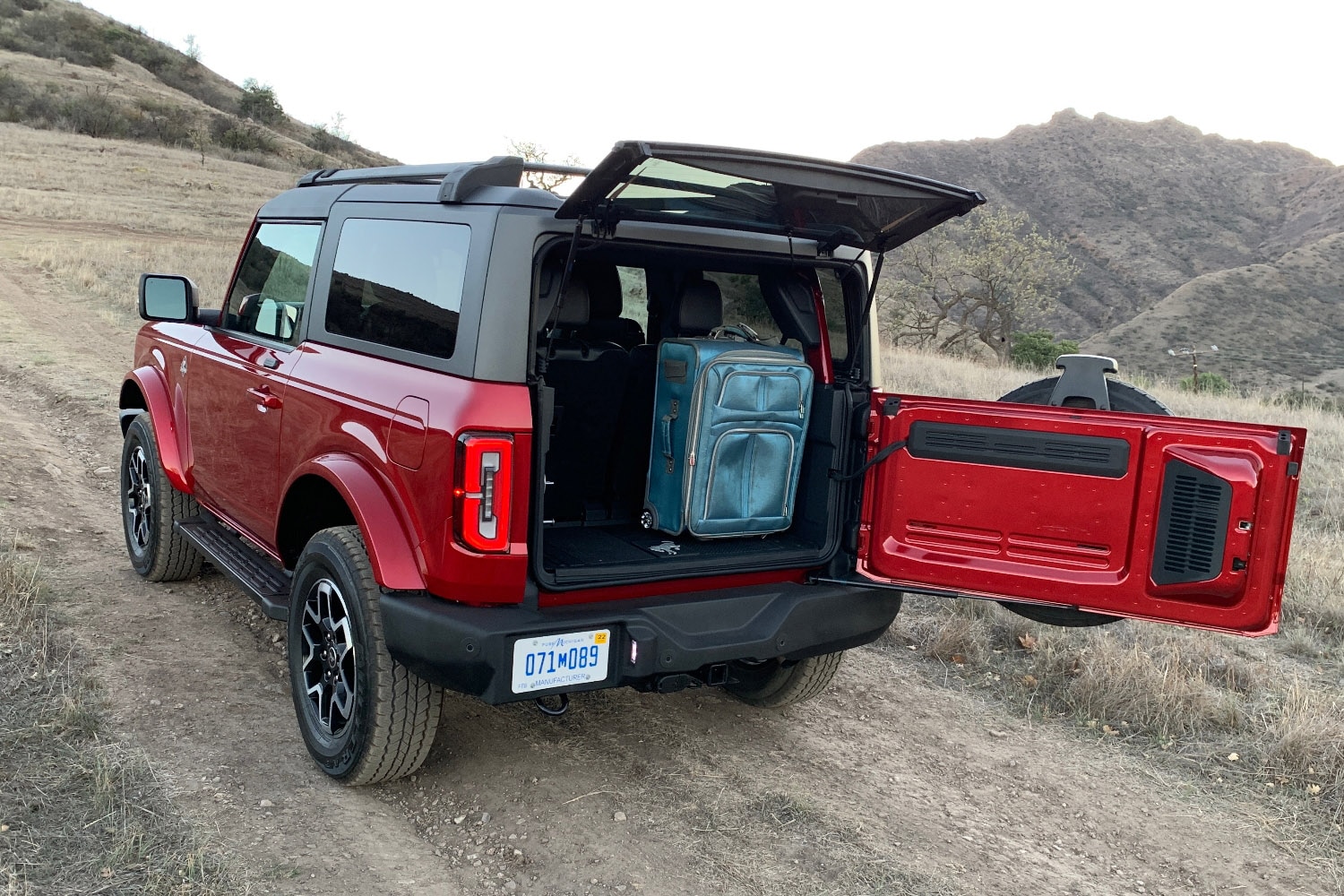 Christian Wardlaw
Christian Wardlaw
As for cargo, the two-door Bronco’s area behind the rear seats measures 22.4 cubic feet and 52.3 cu-ft with the back seats folded as flat as they will go. A Bronco four-door with a soft top can carry 38.3 cu-ft and 83 cu-ft, respectively. These figures exceed what you’ll find with the Wrangler.
Hardtops include a storage bag for the individual roof panels over the two front seats, but this bag was missing from the test vehicle. It is necessary, though, because in the two-door, you cannot lay the panels flat in the cargo area, and there is no way to securely stack them behind or strap them to the rear seat.
Overall, the Bronco’s interior is both more refined and more conventional than a Wrangler’s, though retro and expressive at the same time.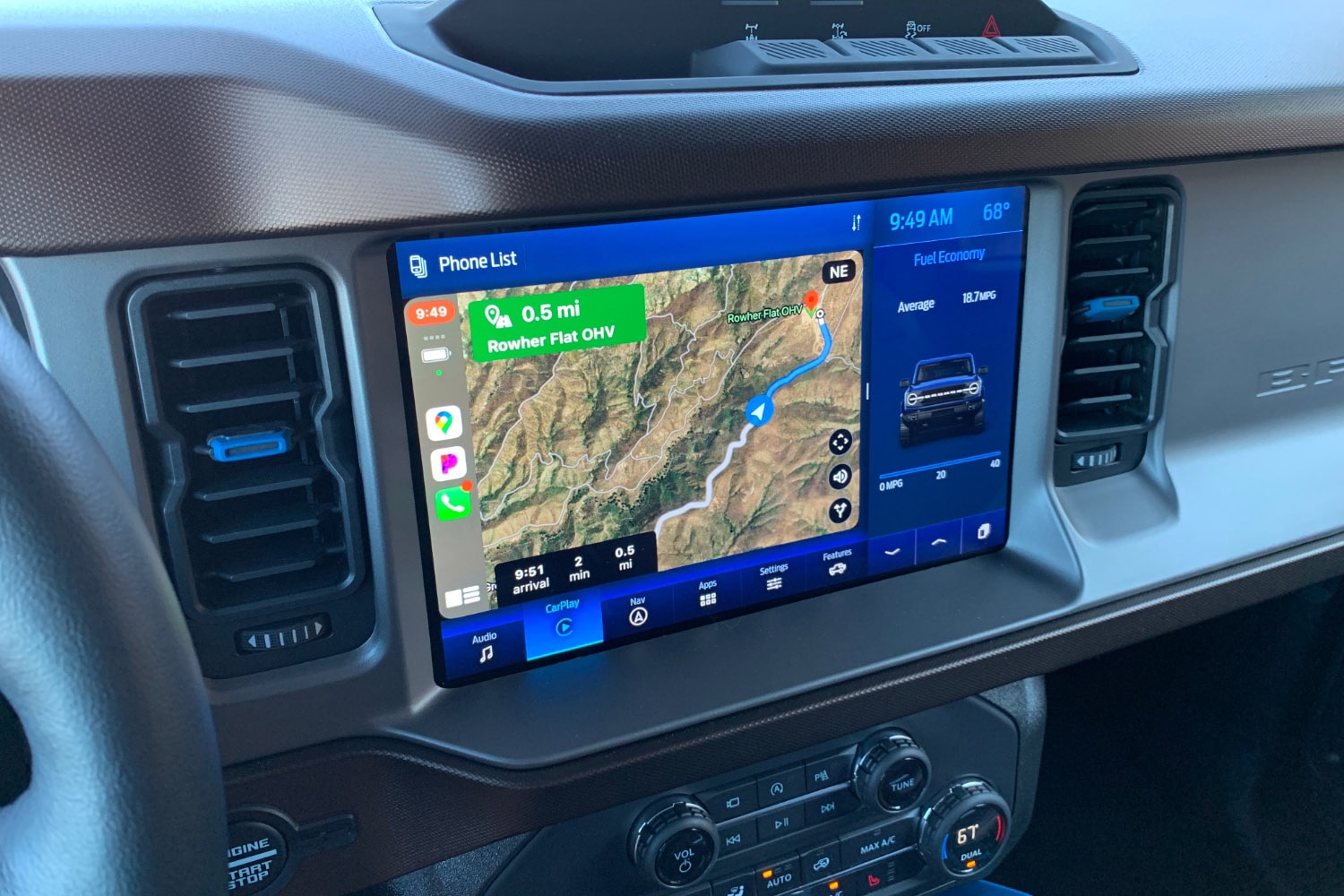 Christian Wardlaw
Christian Wardlaw
BRONCO OFFERS DEFTLY INTEGRATED TECH
Undoubtedly, the Bronco’s technology contributes to the sense of sophistication the SUV conveys. The test vehicle had the top infotainment system and the complete collection of Ford Co-Pilot360 advanced driving-assistance systems. Additionally, it included a Terrain Management System with G.O.A.T. (goes over any terrain) driving modes and Trail Toolbox tech that makes the Bronco more capable off-road.Sync 4 is an excellent, quick-responding infotainment system featuring capable voice recognition and wireless smartphone-mirroring technology. In addition, the test vehicle’s premium audio system delivered clear, rich sound, easily overcoming the wind noise on the highway. The 12-inch touchscreen display is a little bright, though. As a result, I preferred using the “night” mode even during the daytime.
Owners can use the FordPass Performance smartphone app to access an off-road navigation function and even download topographic maps and satellite images to use while exploring regions where connectivity is unavailable. Multiple G.O.A.T. modes are also on deck, including Rock Crawl and Baja (in some versions of the Bronco) to assist with extreme driving situations.
The Trail Toolbox includes:
- Trail Turn Assist, which helps to shrink the Bronco two-door’s already miraculously tight turning radius
- Trail Control, a low-speed cruise control system that allows the driver to concentrate on finding a safe path instead of managing vehicle speed
- Trail 1-Pedal Drive, allowing a driver to accelerate and brake simply by pressing and releasing the Bronco’s accelerator pedal
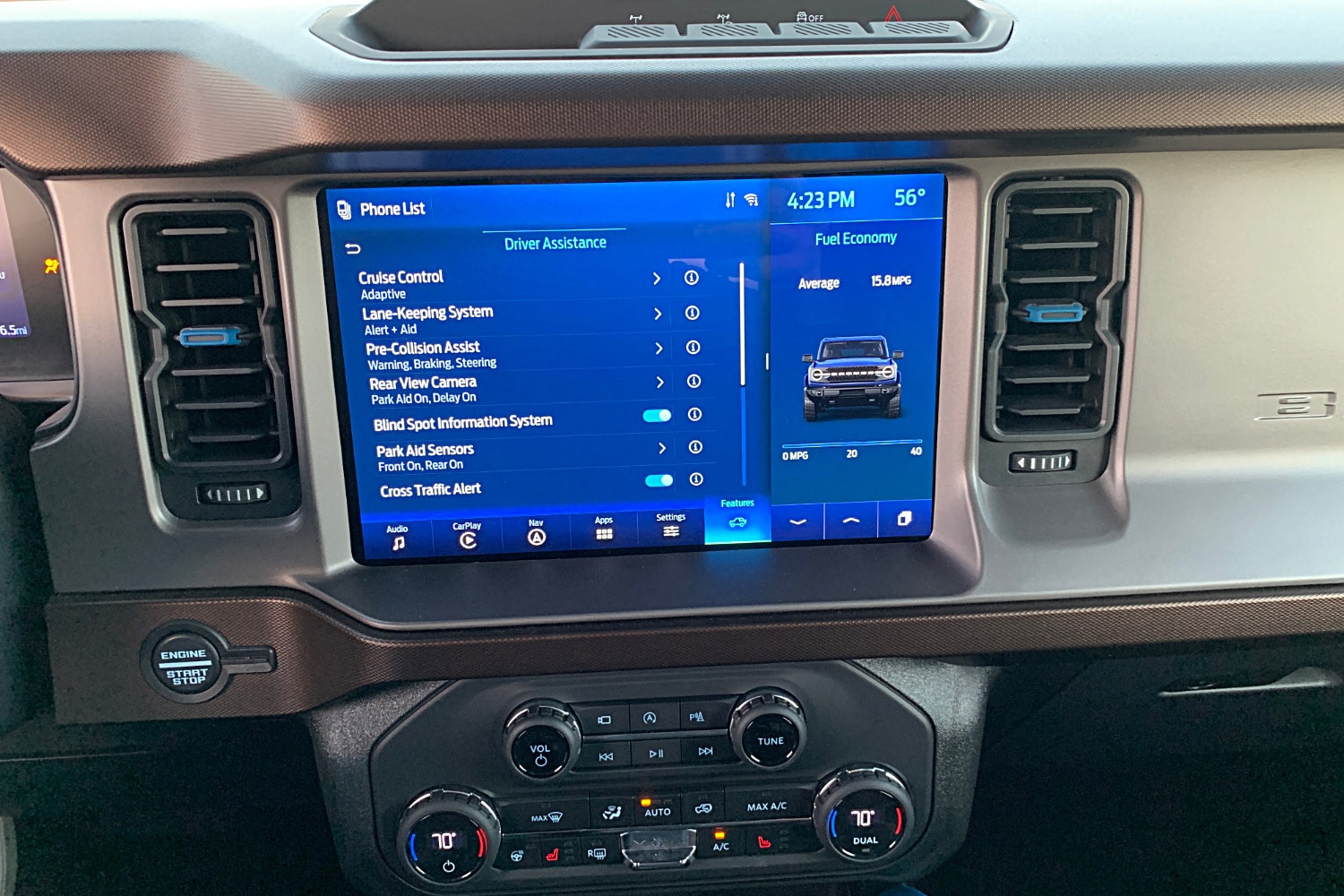 Christian Wardlaw
Christian Wardlaw
A basic version of the Ford Co-Pilot360 package is standard, equipping the Bronco with forward-collision warning, automatic emergency braking, and automatic high-beam headlights. As you move up the trim-level ladder, the SUV adds blind-spot warning, rear cross-traffic warning, lane-departure warning, lane-keeping assistance, and rear parking sensors. Adaptive cruise control is also available*.
Owners can set the safety tech’s sensitivity levels, notification methods, and even deactivate some functions. Use them all, and you’ll find Ford Co-Pilot360 operates in a sophisticated manner. Better yet, you can actually hear and sense the warnings because, aside from wind noise undoubtedly exacerbated by the test vehicle’s optional roof rack and cross-bars, the Bronco is surprisingly quiet inside, and offers a relatively smooth and communicative ride.
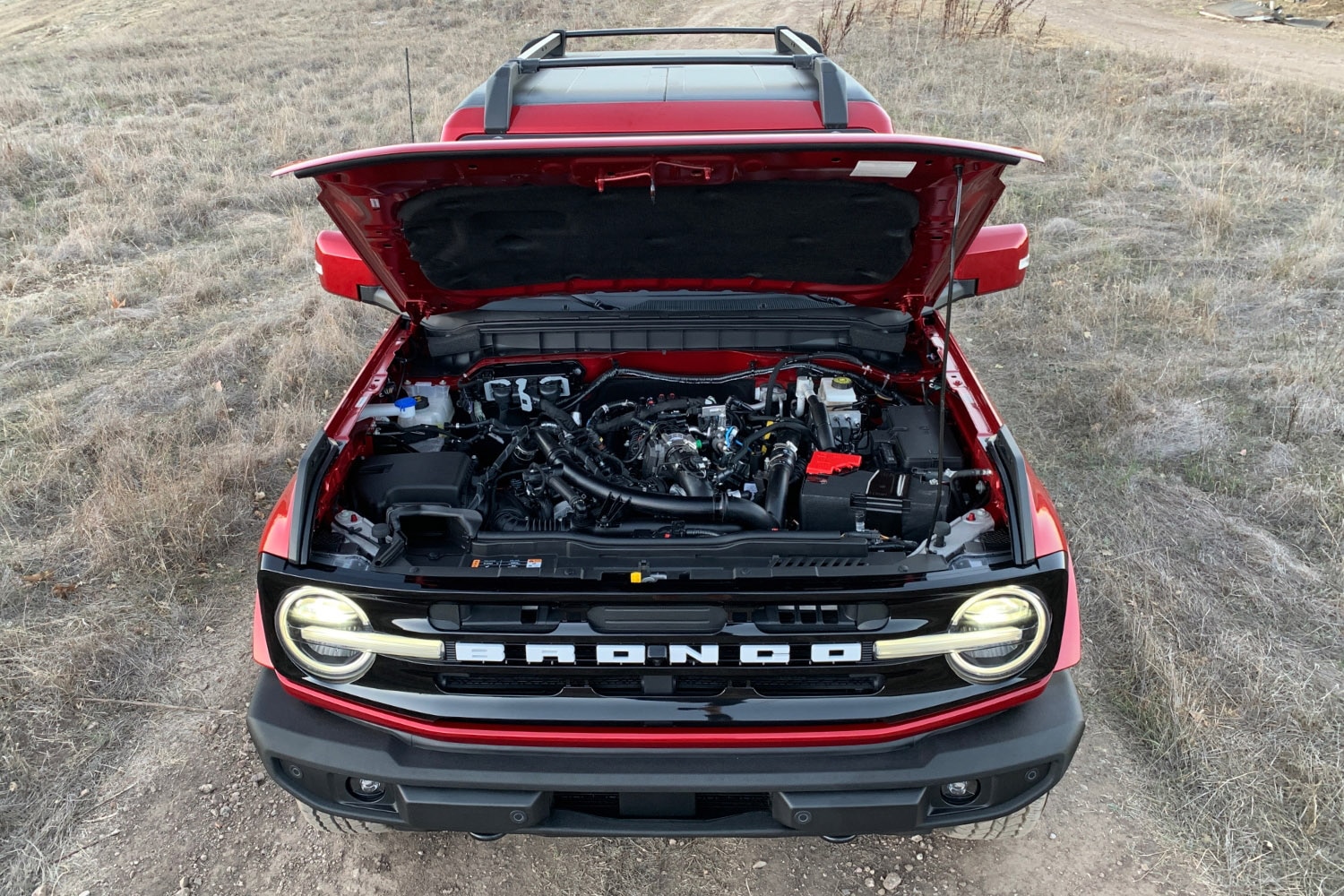 Christian Wardlaw
Christian Wardlaw
A CIVILIZED BEAST
More than anything else, the new Bronco’s driving dynamics distance the Ford from both the Jeep and the only other midsize SUV that offers similar off-roading capability, the aged Toyota 4Runner. The Ford’s main rivals are loud and sloppy on pavement. And even if you plan to spend as much time as possible on dirt, you’re still likely to pile more miles onto your SUV while driving on blacktop and concrete.
Once you’ve climbed behind the steering wheel and peer through the steep windshield, you enjoy an expansive view of both the Bronco’s hood and the SUV’s surroundings. The creased fenders run flat to the Bronco’s blunt nose, capped on the ends with tie-down loops that make placing the SUV on the road or trail easy. An available* 360-degree camera includes off-road views to help guide a driver.
A turbocharged 2.3-liter, four-cylinder engine is standard, generating 275 horsepower on regular gas and 300 hp on premium fuel. Torque varies from 315 pound-feet to 325 lb-ft, depending on what kind of gas you pump into the Bronco. A 7-speed manual transmission with an ultra-low crawler gear for off-roading is standard, while a 10-speed automatic is an option.
A twin-turbocharged, 2.7-liter V6 engine is available as an option. On regular gas, it makes 315 hp and 410 lb-ft. Burn premium, and the engine supplies 330 hp and 415 lb-ft. This engine is exclusively available with the 10-speed automatic transmission.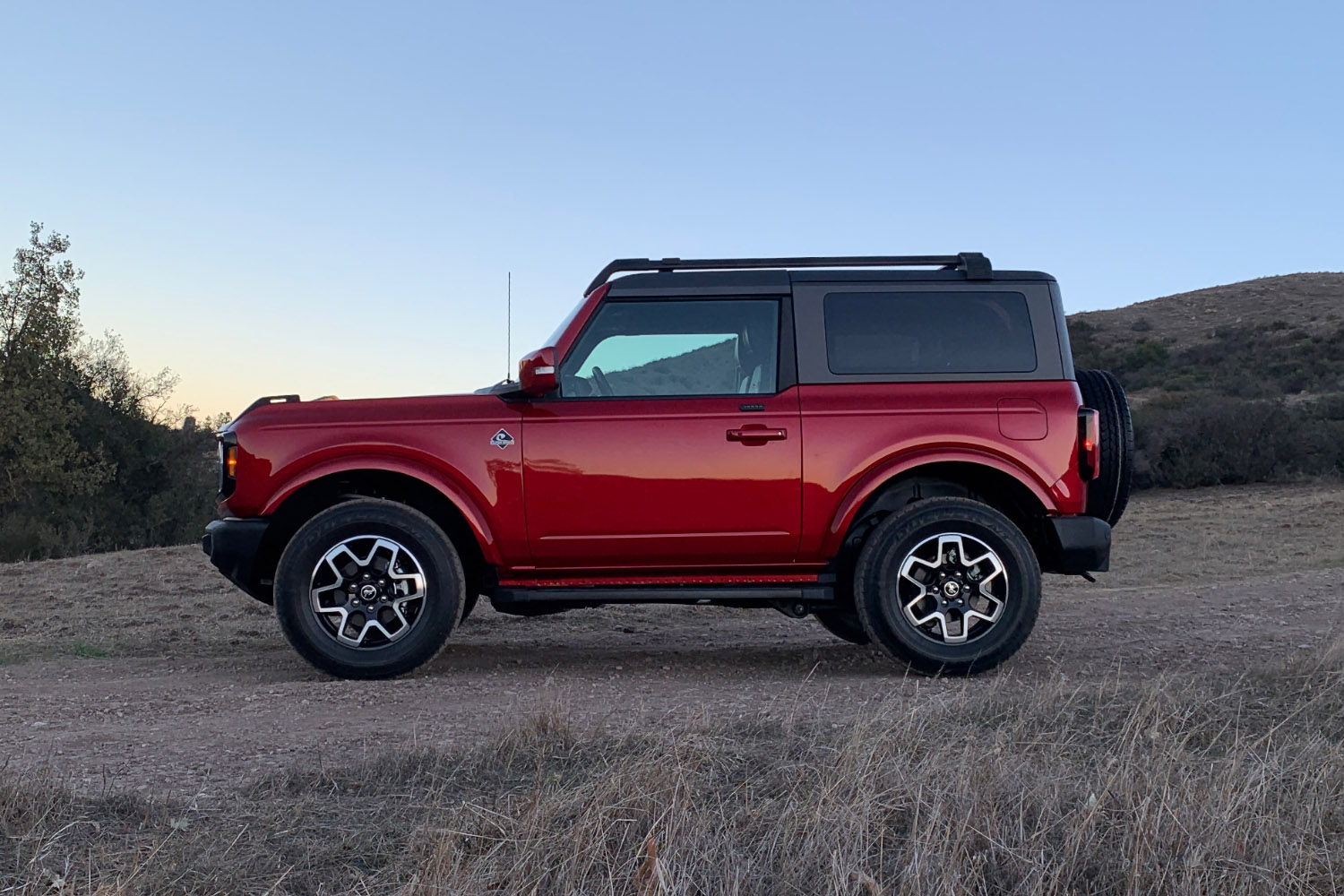 Christian Wardlaw
Christian Wardlaw
Every Bronco has standard four-wheel drive. The turbocharged four-cylinder comes with an electronic, shift-on-the-fly, part-time 4WD system, while the turbo V6 pairs with available* automatic 4WD engagement. Fortified Dana front and rear axles are standard, and Ford says it installs a High-Performance Off-Road Stability Suspension (HOSS) on every Bronco.
A Sasquatch package is available* for all Broncos. It adds 17-inch beadlock-capable aluminum wheels, 35-inch mud-terrain tires, front and rear electronic-locking differentials, a 4.7 final drive ratio, and a lifted suspension with necessary high-clearance fender flares.
Depending on how you spec the new Ford Bronco, these are the minimum and maximum clearances:
- Ground clearance – 8.3 to 11.6 inches
- Water fording – 33.5 inches
- Approach angle – 35.5 to 43.2 degrees
- Breakover angle – 20 to 29 degrees
- Departure angle – 29.7 to 37.2 degrees
Admittedly, I did not come close to exploring the Bronco’s maximum off-road capability. Aside from switching it into the Sand G.O.A.T. mode, choosing the 4WD system’s 4-Hi setting, and then running it down some trails and into some gullies at the Rowher Flat off-highway vehicle park near Santa Clarita, California, nothing I tried challenged the SUV. Then again, my goal was to get out and get home without damaging the Bronco or myself.
Nevertheless, this SUV impressed me. First, the electronic 4WD and G.O.A.T. modes are easy to use. Second, the Bronco two-door is exceptionally maneuverable and offers outstanding outward visibility. Third, even without the Sasquatch package, the suspension is remarkably absorbent and supplies substantial wheel travel.
But you expect the Bronco to perform well off-road. You don’t expect a civilized demeanor everywhere else you drive the SUV.
Though wind noise is loud on the highway, it’s not as deafening as what you experience in a Wrangler (but the Bronco is louder inside than a 4Runner). On-center steering feel is excellent at freeway speeds, and constant correction is unnecessary. The Bronco demonstrates resolute stability at speed, making it comfortable instead of terrifying to drive in the dark on an unknown, two-lane road with approaching 18-wheelers.
Obviously, a Bronco isn’t going to rip around on twisty roads, but it’s better to drive in this environment than its main rivals. Around town, the Bronco supplies a pleasant ride and agile handling, while pummeling crumbling infrastructure into submission. You need not worry about crunching an air dam into a parking block, or curbing one of this SUV’s wheels.
As for the powertrain, the optional twin-turbo V6 is terrific. It delivers robust acceleration accompanied by a pleasing engine note, and while you might assume a 10-speed automatic could easily become confused, the Bronco’s transmission always seems to pick the right gear at the right time.
You’re probably wondering what kind of fuel economy the Ford Bronco gets. The Environmental Protection Agency rates the twin-turbo V6 to return 18 mpg in the city, 20 mpg on the highway, and 19 mpg in combined driving.
Unsurprisingly, the test vehicle's fuel economy averaged 18.9 mpg. It didn’t matter if we ran the Bronco in 2WD on the freeway, in 4WD off-road, in automatic 4WD in the city, with the roof panels on and the windows up, or with the roof panels off and the windows down. The Bronco returned, on average, about 19 mpg. Christian Wardlaw
Christian Wardlaw
IS THE FORD BRONCO TOO GOOD FOR ITS OWN GOOD?
If you want a midsize SUV with significant off-road capability and an open-air driving experience, your choices include the Ford Bronco and Jeep Wrangler. Alternatively, you can open the sunroof and power down all of a Toyota 4Runner’s windows (even the rear glass) to get a similar effect.
Of the three, the Bronco is a better daily driver than either the Jeep or the Toyota. You don’t feel exhausted after hours in the saddle like you can in those two less refined SUVs. Plus, the Bronco’s powerful and torque-rich turbocharged engines perform better at both sea level and altitude.
Is the Bronco a better off-roader than its main rivals? I can’t say, but my hunch is that a Bronco can do anything a Wrangler can. Plus, the Ford is more technologically advanced than the Jeep and Toyota.
Whether Jeep owners and dreamers will defect to the Bronco remains in question. One thing that makes the Wrangler so endearing is its absolute lack of refinement. It looks, feels, and drives like nothing else on the road. The Bronco definitely has some of that same charm, but it is a more civilized beast. That can work both for and against it, depending on your preferences.
Plus, you can go and buy a Wrangler today. Unfortunately, to get your hands on a Bronco, you’ll need to pay a steep premium or wait a long time. As I write this review, instant gratification is not standard with a new Ford Bronco.
Patience, as they say, is a virtue. And with it can come a great reward. Christian Wardlaw
Christian Wardlaw
2021 Ford Bronco Review: Features
Highlights
The 2021 Ford Bronco is a midsize SUV with genuine off-roading capabilities. It comes in two-door and four-door body styles, offers a removable top and doors, and comes with a choice between a turbocharged four-cylinder and a twin-turbocharged V6 engine.
Safety
- Pre-Collision Assist – Standard forward-collision warning system with pedestrian detection
- Automatic emergency braking – Standard automatic braking system to help avoid or lessen the effects of a collision
- Blind Spot Information System – Available* system that warns the driver when other vehicles are in the Bronco’s blind spots
- Lane keeping system – Available* lane-departure warning and lane-keeping assistance system
- Adaptive cruise control – Available* cruise control upgrade that maintains a safe following distance to traffic ahead
Technology
- Sync 4 infotainment system – Standard 8-inch touchscreen and available* 12-inch touchscreen
- Off-road navigation – Available* feature through the FordPass Performance smartphone app
- Trail Control – Available* low-speed cruise control for use on trails
- Trail Turn Assist – Available* feature can tighten the Bronco’s turning radius when navigating challenging trails
- Trail One-Pedal Drive – Available* feature allows the driver to operate the Bronco at low speeds using only the accelerator pedal
Powertrain
- 2.3-liter, turbocharged four-cylinder, 300 hp
- 2.7-liter, twin-turbocharged V6, 330 hp
- Seven-speed manual or 10-speed automatic transmission
- Standard 4WD
- 17 mpg to 21 mpg in combined driving
Interior
- Dual-zone automatic climate control – Available* feature
- Marine-grade vinyl upholstery – Available* mildew-resistant seating material
- Leather upholstery – Available* genuine leather seating material
- Heated front seats and steering wheel – Available* feature
- Premium sound system – Available* feature with ten speakers
*Availability is subject to specific trim level selections
Written by humans.
Edited by humans.
 Christian Wardlaw
Christian WardlawMy first word was “car.” That’s what I’m told, anyway. For as long as I can remember, I’ve been obsessed with them. The design. The engineering. The performance. And the purpose. I’m a car enthusiast who loves to drive, but I’m also most interested in the cars, trucks, and SUVs that people actually buy. Anybody can tell you that a sports car is fast. What you need to know is whether or not you should buy that new SUV, and why. My life purpose is to help you make that decision.
Related articles
View more related articles